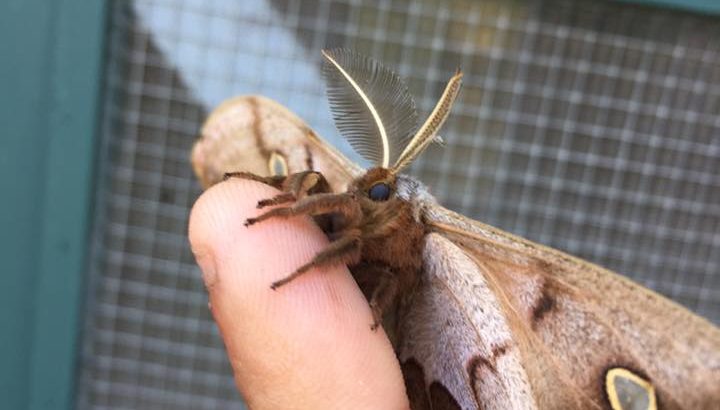Dusk – The slow falling of the grey-blue curtain, chasing the dying fires of sunset. When the last wisps of light disappear, one is greeted with the soft glow of the moon, and sallow wail of loons out on the lake. The stillness betrays the nature of night. It is not at all an ending. At the beck and call of lunar glow and wisps of cool evening wind, nocturnal creatures of all kinds emerge. These all too often misunderstood critters crawl, squirm, forage and fly their way through the night, continuing the circle of life well into the dawn hours at Umbagog.
As one strolls across the base camp on a calm summer night, you may be quite taken aback by something about the size of a bird hanging on the front of the campstore. Above, the shimmering light under the apex of the roof attracts hundreds of dipping, diving, and swirling insects. Below, the larger critter is umoving, begging inspection.
A luna moth, bright and beautiful bathing in moon light has found its nighttime resting spot under the light. On every side of the store front, there are different moths, garbed in swirls of pink and yellow, dark woodland camouflage, bright yellows, ghostly whites, or warm cinnamon with begging eerie eyespots. The camp store at Umbagog seems to be the hotspot for many different species of moth, of every size. It is incredibly surprising to find such a varied mix so consistently each night.


All too often, moths are considered useless, less beautiful brethren of butterflies. This is simply not true. Moth wing patterns are dazzling, and are just as varied in range as their place as some of the most varied organisms on the planet. There around 11,000 species of moth just in the northern United States alone. This leaves the casual observer or “moth-er” with an endless stream of winged insects to identify and appreciate. Many campers, wide eyed approaching the camp store, have exclaimed never seeing moths of such large size, or with such stunning patterns.
The patterns on the wings of both butterflies and moths are made up of tiny, microscopic scales very intricately assembled. They make up the symmetrical waves, swirls, lines and spots on their wings. These are also what appear as “dust” when our hands come into contact with a moth. This is also why we don’t want to handle their wings and degrade them.

Aside from varied wing patterns, both vivacious and cryptic, moths possess many unique attributes. Many adult moths, don’t even need to eat – in fact – they lack organs to do so. The luna moth actually lacks a mouth! Their only mission is to reproduce before the end of their life cycle. Most adult moths only live for about a week, while some can live for up to a month.

Other moths, have developed as fantastic mimics, taking the shape and color patterns of other insects or plants, to avoid attention from their usual predators.


Moths also play an important role in the ecosystem. As caterpillars, they provide an extremely important food source for many different animals. Night fliers are an important part of a bats diet, who in turn take care of thousands of mosquitos every night. The caterpillars of moths are integral to the survival of our beautiful songbirds, as they are a source of food for chicks.


The night skies of Umbagog are quite alive with these creatures who beg more reverence through their beauty and importance. The next time you find yourself at Umbagog, take a nightly stroll down to the beach and up to the camp store to get an up close view of these abundant residents. I’ll be doing night programs on moths for the rest of the summer on Saturday nights at Umbagog State Park. Join me and we’ll discover more about them together!


